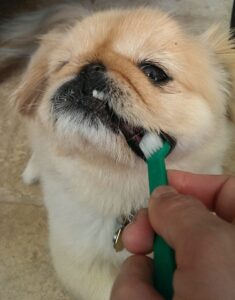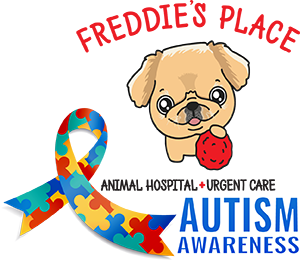 What you Should Know about your Pets Teeth & Gum Health
What you Should Know about your Pets Teeth & Gum Health
February is National Pet Dental Health month, a time to accent the importance of good oral hygiene for our fur kids. Since pets cannot communicate in our language, there are often missed signs and an unintended neglect of their oral health needs. Shockingly, after the age of three, over 80% of dogs and 70% of cats will show symptoms of some dental disease. In today’s Dog Blog, we’ll explore warning signs of potential problem, treatment and prevention steps, and how to setup a good dental health regiment for your fur kids.
What some owners and pet parents don’t realize is that, as it is for humans, poorly maintained teeth and gums can lead to other serious health problems for your dogs and cats. From the more obvious issues of chronic and constant pain, broken or missing teeth, periodontal disease, cysts or tumors in the mouth, broken jaws, and abscessed or infected teeth or gums, poor dental health can also lead to kidney and liver disease, heart disease, and infections spreading from the teeth through the bloodstream to other vital parts of the body. As you can see, a focused approach and routine to basic dental health is very important to the fuzzy ones we love so much.
How Can I Tell if my Pet Has Dental Issues?
As we mentioned before, sometimes it’s not easy to tell when your pet is having tooth aches or dental discomfort. Since they play and entertain themselves with their mouths by play fighting, chewing on bones and treats, and often help themselves to shoes/toys/furniture/sticks/rocks/hard surfaces loss of a tooth could happen at almost any time. The best way to keep up on your pets dental health is to inspect the teeth on a regular basis, we suggest two times a week at a minimum. What your looking for are telltale signs that something has changed or is changing with their oral health.
Look for signs of;
What’s Involved in a Home Exam and How Often Should I Do It?
You are the front line of defense for your pets dental health, so it’s up to you to lead the way by making a routine for checking teeth, gums, and breath. As we mentioned earlier, we suggest you consider a home oral exam twice a week. A great number of pets, cats especially, do not want you up close and digging around their mouth. If you attempt to incorporate your home dental exam with playtime, snuggle time, or as part of some other fun routine, your pet will become used to the personal space inspection. DO NOT force a dental exam, become cross or angry with the animal, or make it a negative chore. Your fur buddy will come to associate any movement towards their mouth to a bad experience with you. If you keep your exams short, fun, and to task, they will take a matter of moments and the pet can enjoy the time with you as part of the loving routine you develop.
If you do notice any of the signs listed above, setup an oral exam with your Primary Care Veterinarian as soon as possible. In addition, make a yearly routine to visit your veterinarian one to two times a year for a scheduled dental checkup. Since February is Pet Dental Health Awareness Month, it’s a great time to schedule an exam. If your DVM suggests a second yearly dental exam, make it during an easy to remember, existing target date, maybe around Labor Day or the start of your human kids school year
What Can I do to Help Promote a More Healthy Dental Lifestyle?
This is easy, you manage the parts where you have direct control. Avoid sugary snacks, or treats for your pets. Like anything else, these are fine in moderation and under your guidance. Treats from the table are also laced with hidden sugars and acids that will promote tooth decay. Hard foods, hard plastic toys, bones or rawhide’s, hard treats, sticks and rocks, these can all cause tooth loss, breakage, or damage to gums. That’s not to say your pet can’t have these ever, but it’s up to you to limit the amount of items and time spend chewing.
Brushing is very important, as well. Just like with your teeth, a good brushing will help to break down plaque, scrub away bacteria, and keep breath fresh and clean. Pet health products have made advances in the pet dental care area and created some fantastic, innovative new items. Finger brushes (a nubbed finger cot that massages the gums while it clean the teeth) helps to avoid the basic “stick with a brush on the end”, and gives you much more targeted control. It also is not as scary or intrusive has a plastic rod bouncing around in their mouths. They also make a pet sized traditional tooth brush, if you are wary of putting your finger in your pets mouth. There are also “pet” tooth pastes in chicken and beef flavors. Most of these products will not foam and can be swallowed with no ill effects. In a pinch, you can also use baking soda, but we can’t vouch for your dogs approval of that taste and feel.
Keep in mind that the main target areas to brush should be at the gum line, especially on the hidden cheek areas. A nice scrub of the tongue is helpful as well, if your pet will tolerate it. As we said earlier, make this fun and not a negative thing. Your pet will pick up your stress immediately, so be cool Mom & Dad. A wide spread cheat is to start off my rubbing the pets lips with beef or chicken broth. From there, you introduce the finger or brush into their mouth with the broth. From there you can start some brushing, pulling back if the pet struggles. If done right, this becomes a fun an enjoyable treat time and not a WWE wresting match in your living room.
Dental treats are also available in many sizes, flavors, and shapes. These are hard treats, but the majority of these dissolve as they are chewed and have plaque fighting ingredients, as well as teeth cleaning nubs. It’s important to match the treat to the pets size and to monitor/control how long and often the pets chews. Several organizations, such as the American Kennel Club (AKC) and American Veterinary Dental College (VOHC) have stated that dental treats can help with overall pet dental health and help to lessen the need for dental cleanings.
What Happens during a Veterinary Dental Exam & Cleaning?
The basic dental exam comes in two types in most veterinarian offices, with or without anesthesia. Very few pets qualify or could tolerate the non-anesthetic exam and cleaning. Think of it this way, imagine you have no idea what a dental examination is, and you don’t speak the language of the doctor who is performing it. All the noises and tools are foreign, people are sticking their hands and tools in your mouth. You would likely panic and fight back… well, that is what you pet is experiencing if not sedated. However, if your pet is cooperative, if your vet offers the service, and if the work isn’t too time consuming or deep in the mouth, some veterinarians do offer a non-anesthetic option. Pet owners always have concern when anesthetic is involved in a procedure with their fur kids. In today’s world of veterinary medicine, pets receive pre-anestheic blood testing to assure they can can tolerate the process. They also take steps to assure a clear and constant breathing pathway by using a breathing tube. The constant monitoring of the airway, oxygen levels, and anesthetic delivery make the process safe and painless.
During the exam and cleaning the veterinary team will remove visible plaque and tarter build up on the teeth and gum line. They will look for visible signs of disease or infection, taken dental x-rays to look for hidden problems or decay, polish the tooth surface to remove bacteria hiding scratches, apply and fluoride treatment and inspect the mouth/tongue/lips/teeth/gums. If found, they can remove any infected or damaged teeth. It’s not really different from the process your dentist follows with your exams and cleanings.
As you can see, your pets dental health in an ongoing process that mirrors your own oral routines. If you consider that poor oral hygiene and dental disease can cause pain, sickness, and potentially shorten a pets life, it just makes good parenting sense to take action and build a plan towards better dental health. Depending on your pet insurance carrier and the options you chose, certain plans include cleanings and preventative care. You can also purchase stand alone pet dental insurance.
During National Pet Dental Awareness Month, Freddie’s Place is offering a special promotion for pet parents in the San Diego, and North County area. If you make a dental exam appointment with Freddie’s Place Best Care Anywhere Team in February, you will receive 15% off your dental service. In addition, you will receive 15% off your pre-anesthetic dental exam. It’s a great offer to start your pets on the road to great dental health. Call us at 760-Freddie (760-373-3373) or stop into our Place.
That’s all the news that is news from National Pet Dental Health Month, and from our Dog Blog for this week. We hope you gained some knowledge and have a better understanding of the importance of your pets oral health. We certainly want to see your fur kids with bright shining faces and teeth in right places. If you enjoyed this weeks #FreddieSez, remember that we have a full library of Dog Blogs with wide ranging topics, and they are all located at our web home. We’d love for you to “dig in” and read to your hearts content.
Till we meet again next week, make that pet dental plan for your household, take time to hang out with the pets you love, be the person your pets think you are, and always be Pet Friendly… #FreddieSez





Leave A Comment